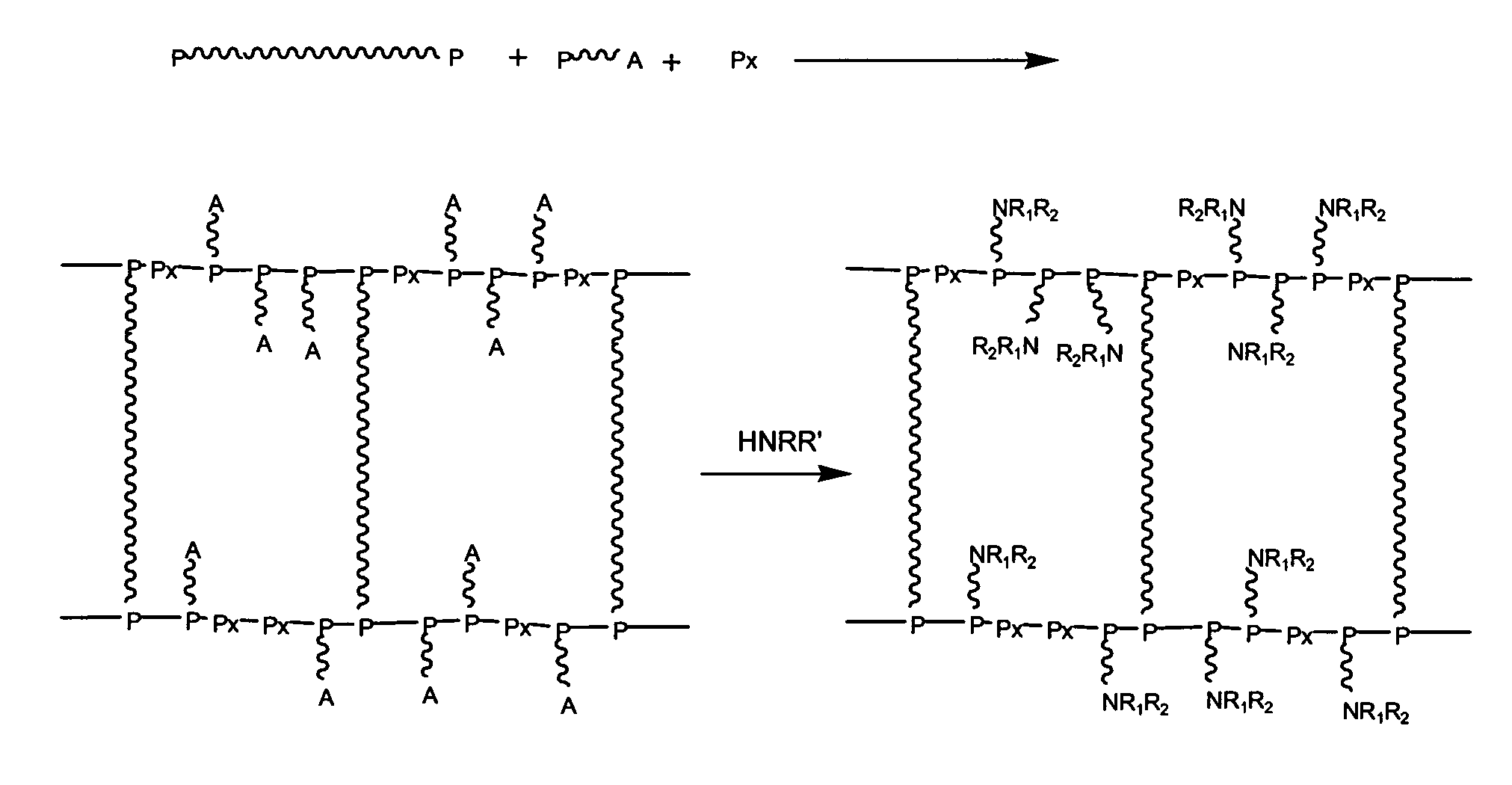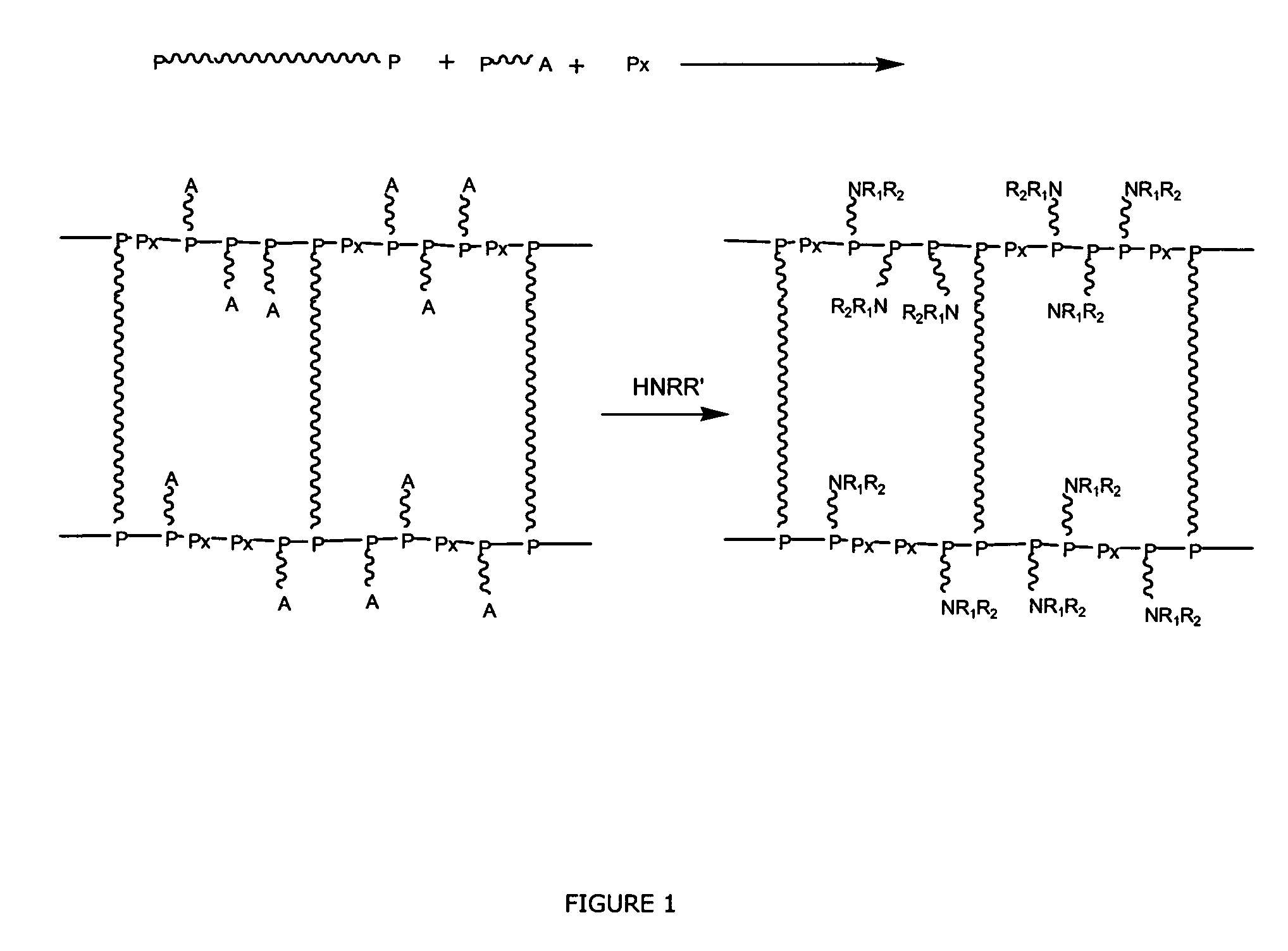Polyether Polymer Matrix
a polymer matrix and polymer technology, applied in the field of polymer resins, can solve the problems of limiting the accessibility of reagents, peg-grafted ps-dvb, and dvb supports such as tentagel
- Summary
- Abstract
- Description
- Claims
- Application Information
AI Technical Summary
Benefits of technology
Problems solved by technology
Method used
Image
Examples
example 1
Preparation of High Capacity Resin
[0063]The beaded polymer resin was prepared by an inverse suspension polymerization method. To a flask containing 10 g of water, 0.81 g bisacrylolated Jeffamine ED-900 having a molecular weight of ˜1100 g / mol and 4.19 g Bisomer PEA6 (Mn=336 g / mol) were added. The reaction mixture was subjected to N2 for 15 minutes, whereafter 0.30 g ammonium persulfate was dissolved into the solution. To a three-necked baffled flask, equipped with a mechanical stirrer, 100 ml of paraffin oil and 0.050 g of a surfactant were added and heated to 70° C. The reaction mixture was then added to the oil forming a suspension of beads. After approximately 1 minute of reaction time, 0.569 ml of 1,2-Di-(dimethylamino)-ethane was injected to suspension mixture. The chemical synthesis, i.e. network formation, was performed at 70° C. for 20 h. After the synthesis, the resulting beads were filtrated from the oil phase. The beads were then sequentially washed with dichloromethane, ...
example 2
Transfer of Hydroxyl to Amine Functionality
[0064]To 2.5 g resin (swelled in water), produced according to example 1, 5 ml of triethyleneglycol diamine was added at room temperature, followed by the addition of 0.0046 g of potassium tert-butoxide. The reaction mixture was stirred for 20 h at a temperature of 120° C. The resin was then washed with water and ethanol to remove residuals. The degree of amine functionality (amine capacity, loading) was analyzed to 2.2 mol / kg. The swelling performance in water was determined to 10.8 ml / g.
example 3
Preparation of High Capacity Resin
[0065]The beaded polymer resin was prepared by an inverse suspension polymerization method. To a flask containing 15 g of water, 1.2 g bisacrylolated Jeffamine ED-2003 having a molecular weight of ˜2050 g / mol and 3.76 g Bisomer PEA6 (Mn=336 g / mol) were added. The reaction mixture was subjected to N2 for 15 minutes, whereafter 0.328 g ammonium persulfate was dissolved into the solution. To a three-necked baffled flask, equipped with a mechanical stirrer, 100 ml of paraffin oil and 0.050 g of a surfactant were added and heated to 70° C. The reaction mixture was then added to the oil forming a suspension of beads. After approximately 1 minute of reaction time, 0.621 ml of 1,2-Di-(dimethylamino)-ethane was injected to suspension mixture. The chemical synthesis, i.e. network formation, was performed at 70° C. for 20 h. After the synthesis, the resulting beads were filtrated from the oil phase. The beads were then sequentially washed with dichloromethane,...
PUM
| Property | Measurement | Unit |
|---|---|---|
| temperature | aaaaa | aaaaa |
| temperature | aaaaa | aaaaa |
| temperature | aaaaa | aaaaa |
Abstract
Description
Claims
Application Information
 Login to View More
Login to View More - R&D
- Intellectual Property
- Life Sciences
- Materials
- Tech Scout
- Unparalleled Data Quality
- Higher Quality Content
- 60% Fewer Hallucinations
Browse by: Latest US Patents, China's latest patents, Technical Efficacy Thesaurus, Application Domain, Technology Topic, Popular Technical Reports.
© 2025 PatSnap. All rights reserved.Legal|Privacy policy|Modern Slavery Act Transparency Statement|Sitemap|About US| Contact US: help@patsnap.com


